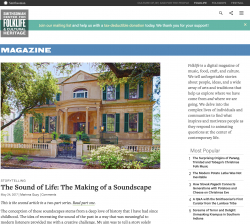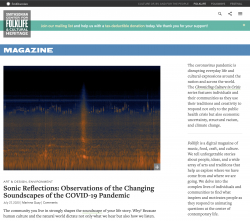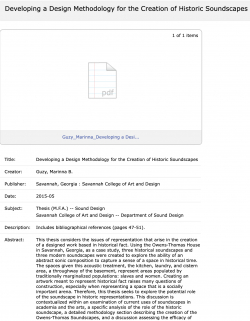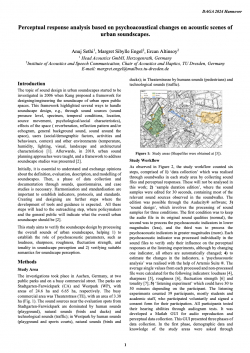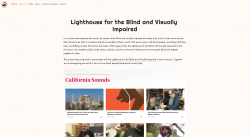The Sound of Life: What Is a Soundscape? (Part 1)
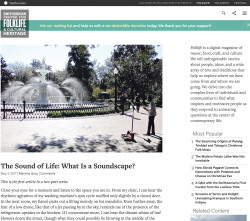
Type
Publication
Authors
Guzy ( Marinna Guzy )
Category
Article
[ Browse Items ]
Publication Year
2017
Publisher
Smithsonian Center for Folklife and Cultural Heritage, United States
URL
[ private ]
Abstract
"Close your eyes for a moment and listen to the space you are in. From my chair, I can hear the rhythmic agitation of my washing machine’s spin cycle muffled only slightly by a closed door. In the next room, my fiancé picks out a lilting melody on his mandolin. Even further away, the hint of a low drone, like that of a jet passing by in the sky, reminds me of the presence of the refrigerator upstairs in the kitchen. If I concentrate more, I can hear the distant whine of leaf blowers down the street, though what they could possibly be blowing in the middle of the winter is beyond me. And right next to the click clack of my typing as I commit these words to the page is the purr of an external hard drive, a reassuring sounding of the digital age.
These are the sounds of my daily life. These sounds possess many universalities shared by the peoples of the world: sonic reminders of electricity, indoor plumbing, the combustion engine. Yet they are also simultaneously totally unique to the place they occur, and may include the far-off cry of the rooster, or a call to prayer.
As you read the above passage, you likely heard the sounds described in your mind, a process called audiation. While my audiation may be different from my friend’s, the vivid mental sonic imagery illustrates the power of sound as a medium for communication. It can relay meaning, emotion, memory, and facts through language, music, and field recordings. Sound, when understood as an environment, is a soundscape: a powerful tool that helps humans relate to their surroundings. They can be consciously designed by an individual or group of individuals, or the byproduct of historical, political, and cultural circumstances. They may be musical compositions, ethnographic anthropological field recordings, recordings of a rainforest taken by an ecologist, or imaginings of a sound designer/historian ruminating upon the sounds of the past..."
These are the sounds of my daily life. These sounds possess many universalities shared by the peoples of the world: sonic reminders of electricity, indoor plumbing, the combustion engine. Yet they are also simultaneously totally unique to the place they occur, and may include the far-off cry of the rooster, or a call to prayer.
As you read the above passage, you likely heard the sounds described in your mind, a process called audiation. While my audiation may be different from my friend’s, the vivid mental sonic imagery illustrates the power of sound as a medium for communication. It can relay meaning, emotion, memory, and facts through language, music, and field recordings. Sound, when understood as an environment, is a soundscape: a powerful tool that helps humans relate to their surroundings. They can be consciously designed by an individual or group of individuals, or the byproduct of historical, political, and cultural circumstances. They may be musical compositions, ethnographic anthropological field recordings, recordings of a rainforest taken by an ecologist, or imaginings of a sound designer/historian ruminating upon the sounds of the past..."
Description
https://folklife.si.edu/talkstory/the-sound-of-life-what-is-a-soundscape
Number of Copies
1
| Library | Accession No | Call No | Copy No | Edition | Location | Availability |
|---|---|---|---|---|---|---|
| Main | 396 | 1 | Yes |
